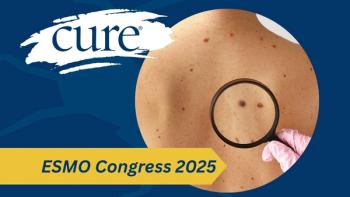
Drug Combination Improves Outcomes for Melanoma Subtype
In a recent phase 2 study, nearly half of patients who had resectable stage 3B/C BRAF V600-mutant melanoma achieved pathologic complete response (pCR) – meaning that no active cancer cells are present – with neoadjuvant combination therapy consisting of Tafinlar (dabrafenib) and Mekinist (trametinib).
Alexander M. Menzies, M.D.
In a recent phase 2 study, nearly half of patients who had resectable stage 3B/C BRAF V600-mutant melanoma achieved pathologic complete response (pCR) — meaning that no active cancer cells are present – with neoadjuvant combination therapy consisting of Tafinlar (dabrafenib) and Mekinist (trametinib).
Additionally, no patients experienced disease progression during the neoadjuvant treatment, said Alexander M. Menzies, M.D., who presented the data at the 2017 ESMO Congress in Madrid.
“Nearly 50 percent of our patients had a complete eradication of their melanoma at the time of surgery. Fifty percent had some remaining melanoma in the surgical specimen, but every patient had some degree of tumor shrinkage on therapy,” said Menzies, a medical oncologist and senior research fellow at Melanoma Institute Australia in Sydney, Australia. “These are patients who otherwise would just have surgery and then have observation. And, these are patients who are at very high risk, probably the highest risk of recurrence without further therapy.”
The study recruited 35 patients with histologically confirmed bulky stage 3B (17 percent) or 3C (83 percent) who received Tafinlar at 150 mg twice daily and Mekinist at 2 mg once daily for 12 weeks prior to therapeutic dissection of the pre-therapy tumor bed, followed by another 40 weeks of Tafinlar and Mekinist. To be eligible for enrollment, patients had to have BRAF V600 mutation-positive melanoma.
Computed tomography (CT) and positron emission tomography scans were performed at baseline and 12 weeks prior to resection to assess for response rate. CT monitoring was continued every 12 weeks thereafter to two years and then every six months to three years. Biopsies were performed at baseline and at week one. The primary endpoints of the study were the rate of pCR and the RECIST response rate at week 12.
At a median follow-up of 17.6 months, the pCR rate was 49 percent and the complete response (CR) rate by RECIST was 46 percent. The CR by metabolic response was 51 percent.
The recurrence rates were 35 percent in those who achieved pCR and 39 percent in those who did not. With immunotherapy, pCR does appear to correlate with recurrence, Menzies added.
“What we have seen with follow-up though is that, despite half the patients having a pCR, we are seeing recurrences,” he said. “They seem, at this stage, to be occurring just as often in patients who had a pCR as those that didn't, and it seems like the recurrence-free survival is similar in those two groups as well. What we worry is that, at the end of the day — when we get to five years — are there just as many people in whom the melanoma's come back and died that received targeted therapy or not?”
The median time to recurrence was 11.7 months. Seven patients recurred in less than 12 months (four on treatment). Baseline circulating tumor DNA did not correlate with recurrence. The pCR was often discordant with the imaging response; only 65 percent of patients with pCR had a CR by RECIST and metabolic criteria. Two patients died due to their disease; one at 12 months and the other at 15.2 months.
“When people are recurring, there are no particular patterns,” he continued. About one-third of patients (38 percent) recurred in the locoregional area, one-third (38 percent) in extracranial sites and 23 percent in the brain, “which is not unexpected when we look at resistance to that type of therapy in the metastatic setting, but certainly a problem in this group, as well.”
No patient discontinued treatment with Tafinlar / Mekinist during the neoadjuvant phase. Eleven patients discontinued during the adjuvant phase — five for toxicity and three for disease recurrence. Three-fourths of patients (74 percent) experienced fever.
In 16 of the 35 patients (46 percent), the surgeon-rated operability as improved. Eighteen patients (55 percent) had at least surgical complication; 12 had a wound infection that required antibiotics, five had a seroma and two experienced bleeding.
The reasons for performing the trial were three-fold, explained Menzies. The first was to obtain true data about how neoadjuvant therapy improves operability and how it affects the rate of pCR, data that have been absent until now. The second was to set up a neoadjuvant framework in which new drugs and new combinations could be tested more efficiently than in the metastatic setting.
“Because we get all the biopsies, we can do valuable translational research to try and understand exactly how the drugs are working, exactly why some people aren't responding well to therapy, and also look at why people are developing recurrence despite having a great response in that initial area,” he said. “The third reason was to try and see if we could correlate pCR with survival, and that said, at this point it looks like that’s not correlating but it may be a unique thing of targeted therapy rather than neoadjuvant therapy and melanoma in general.”





